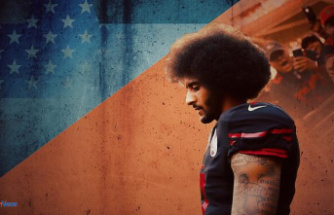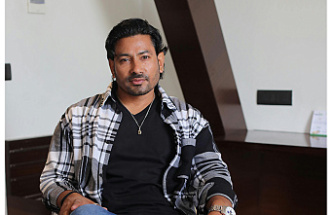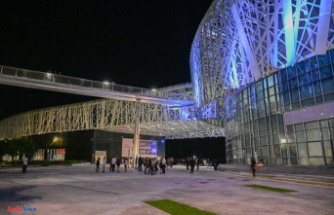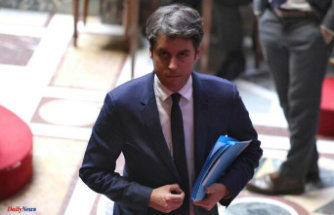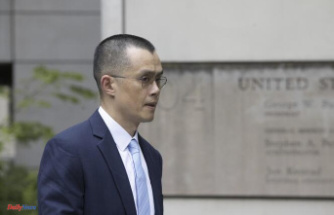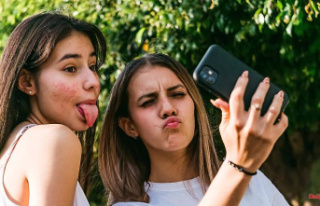In the beginning there was a circle of friends. They know each other from school or work. East Friesland is the connection. They all come back again and again and love this area. Now they have put on an art show within a year, combining art and landscape. For the 1st Ostfriesland Biennale, the best thing for visitors to do is get on their bikes: 30 artists can be found at 17 locations over a distance of 250 kilometres. In castles, palaces, churches, gardens or museums, the audience encounters a skilful mix of stars like Jonathan Meese or Alicja Kwade and - still - unknown people. n-tv.de met Ina Grätz, art historian and chairwoman of the association Ostfriesland Biennale e.V. A conversation about the land, art, sea, crossing borders, tattoos, tea and jokes.
n-tv.de: Why does Ostfriesland need a biennial?
Ina Grätz: We have a multi-faceted landscape here that changes quickly on a compressed surface. There is the Wadden Sea, the North Sea, moors, forests, the marsh. We wanted to combine that with art in our circle of friends. That was the birth of the Biennale last year. What's exciting is that we're also showing cross-border art in the Netherlands.
Why there?
The Netherlands towards Groningen also have fascinating places, castles, museums and a similar landscape. So why stop at the border when the landscape doesn't stop at the border either? In addition, our Biennale should not be a flash in the pan, so we thought big.
They are almost limitless. What else makes the Biennale different?
Landscape is our main theme. For the very first time in East Friesland, there is such a large exhibition of contemporary art that can be experienced outside of a museum.
Can you give an example?
When selecting the works, it was important to us that there was a connection between the location and the work of art. The connection to the place was not created by the artists, but by us. In this way we can also tell cultural-historical stories. For example, the artist Marc Brandenburg dealt with tattoos in Berlin. They play a completely different role here in East Friesland than in the city. Because for the sailor, the tattoo was a way of identification if he died at sea. The young artist Lena Marie Emrich has installed a bench in the Evenburg Castle Park that opens up different perspectives. If you take a seat on it, you look at the historic castle on one side, at the farm and the parking situation on the other.
How did you come into contact with artists like Alicja Kwade, Tony Cragg or Jonathan Meese? To name a few of the well-known names involved.
One thing led to another, it was a dynamic process, otherwise none of this would have been possible. The places inspired us, then we had suitable works in mind and had endless conversations. Many only know East Friesland from driving through. We now have partnerships with the museums in Emden, Groningen and Wilhelmshaven and are happy with the response.
So Ostfriesland can do art?
Definitely!
In your opinion, what should the audience definitely not miss?
I have to give two answers: We want the landscape to be perceived equally, it is our starting point. The East Frisian landscape is our exhibition location, the sky is incredible and the view can wander for miles. Visitors should experience the landscape in all its facets, so please grab a bike. The other answer, as must-sees for art, the curious should definitely visit the places they don't know. With that we surprise.
Did you experience any surprises yourself when planning the Biennale?
What I took with me, and what was surprising, is how much support we received from the Dutch and East Frisians. This "Yes, we're participating" is fascinating and supports our project.
Where does your enthusiasm come from?
That is something that is in us East Frisians. We motivated each other. Founded the association to implement the Biennale here. We are essentially eight people and many others have joined us in the meantime.
Doesn't sound like the slow-witted East Frisian from the jokes...
(laughs) Oh, that's a stupid cliché.
According to the encyclopedia, the East Frisian jokes originated in the 1960s in Ammerland near Oldenburg and were intended as small teasing. This triggered a wave of jokes across Germany.
After all, many people know Ostfriesland as a result. When I name the village where I come from, you don't know it. But if I say: "I'm from East Friesland", you can classify that, that's what the jokes brought with it. I am a so-called Butenostfriesian, so I was born and raised here, but then left the country. Butenostfriesen often have a close relationship to their homeland, we are shaped by memories. That's why the reference to the bike is so important to me, because then you perceive the landscape and the sky together with the art. You spoke of enthusiasm - we just want to share our enthusiasm for East Friesland.
Sea, tea and Otto Waalkes also spontaneously come to mind when I think of Ostfriesland...
We're proud of that too. We really celebrate drinking tea here. For me, seafaring is one of them. There are many references, the sea is incredibly important. And then there is something really special in our history: the Frisian freedom.
You have to explain that please....
This was a unique form of society in East Friesland in the Middle Ages and meant a high degree of autonomy and little hierarchy for the East Frisians. It is particularly exciting that pirates like Klaus Störtebeker were also in East Friesland at this time. There are still castles and buildings from this time with a very unique architecture.
How would you make Ostfriesland palatable to someone who has never been there?
Ostfriesland and the Biennale will surprise and delight visitors. In the past two years with the pandemic, everyone has longed for deceleration and peace, you can find that here. Visitors don't see everything in one place and in one exhibition. You have to take the time to get to know very different places and discover the art.
Now I have to come around the corner with the jokes again...
(laughs) Sure, I should tell you one. I can only think of one, which I found funny as a child, but not at all anymore: Why are East Frisian buses so wide at the front?
No idea.
Because everyone wants to sit in the front row...
It doesn't matter which row I'm in, I'd love to go to East Friesland straight away. Last question: What are you doing differently for the 2nd Biennale in 2024?
The first edition is a good foundation, and we will build on that. But actually we have the vision to go even further, because there are so many special places hidden here. I also wish that works of art were created especially for East Friesland, this time there simply wasn't the time for that.
Juliane Rohr spoke to Ina Grätz
Ostfriesland Biennale until September 4th, all information about the locations can be found here.


